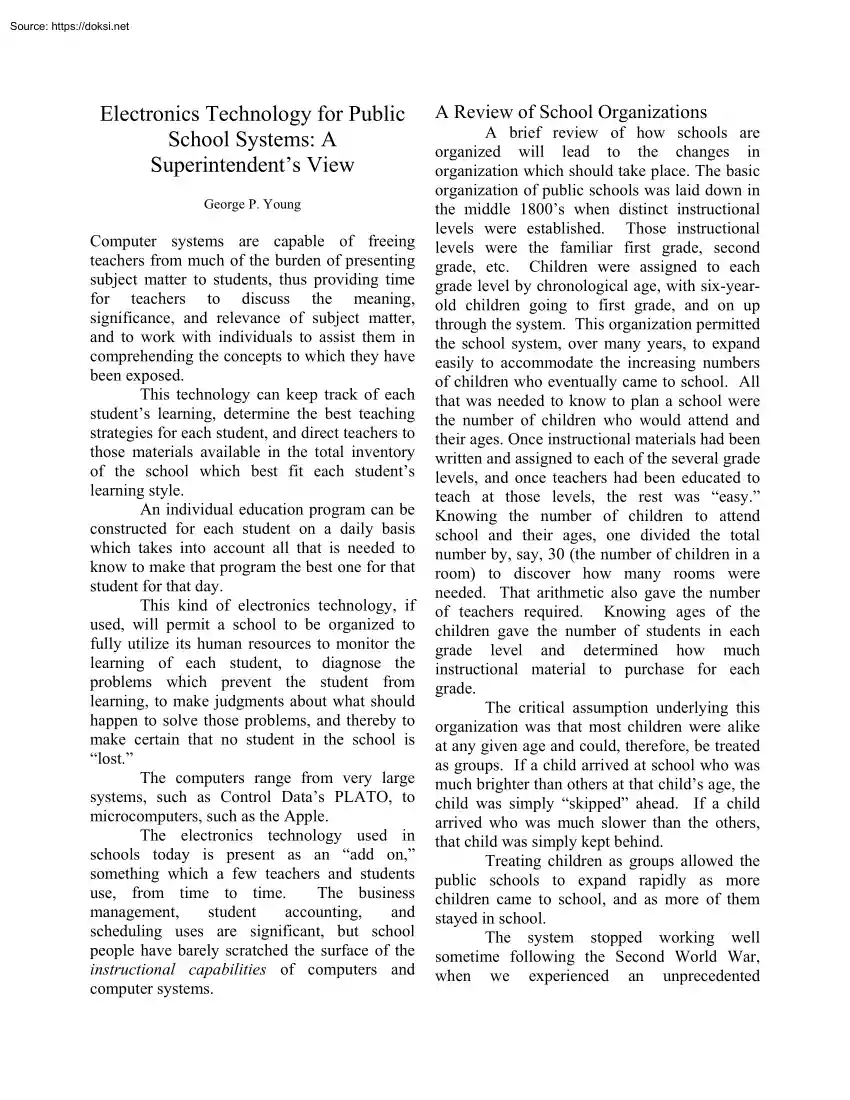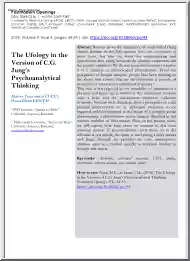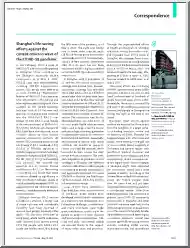Értékelések
Nincs még értékelés. Legyél Te az első!
Mit olvastak a többiek, ha ezzel végeztek?
Tartalmi kivonat
Electronics Technology for Public School Systems: A Superintendent’s View George P. Young Computer systems are capable of freeing teachers from much of the burden of presenting subject matter to students, thus providing time for teachers to discuss the meaning, significance, and relevance of subject matter, and to work with individuals to assist them in comprehending the concepts to which they have been exposed. This technology can keep track of each student’s learning, determine the best teaching strategies for each student, and direct teachers to those materials available in the total inventory of the school which best fit each student’s learning style. An individual education program can be constructed for each student on a daily basis which takes into account all that is needed to know to make that program the best one for that student for that day. This kind of electronics technology, if used, will permit a school to be organized to fully utilize its human resources to
monitor the learning of each student, to diagnose the problems which prevent the student from learning, to make judgments about what should happen to solve those problems, and thereby to make certain that no student in the school is “lost.” The computers range from very large systems, such as Control Data’s PLATO, to microcomputers, such as the Apple. The electronics technology used in schools today is present as an “add on,” something which a few teachers and students use, from time to time. The business management, student accounting, and scheduling uses are significant, but school people have barely scratched the surface of the instructional capabilities of computers and computer systems. A Review of School Organizations A brief review of how schools are organized will lead to the changes in organization which should take place. The basic organization of public schools was laid down in the middle 1800’s when distinct instructional levels were established. Those
instructional levels were the familiar first grade, second grade, etc. Children were assigned to each grade level by chronological age, with six-yearold children going to first grade, and on up through the system. This organization permitted the school system, over many years, to expand easily to accommodate the increasing numbers of children who eventually came to school. All that was needed to know to plan a school were the number of children who would attend and their ages. Once instructional materials had been written and assigned to each of the several grade levels, and once teachers had been educated to teach at those levels, the rest was “easy.” Knowing the number of children to attend school and their ages, one divided the total number by, say, 30 (the number of children in a room) to discover how many rooms were needed. That arithmetic also gave the number of teachers required. Knowing ages of the children gave the number of students in each grade level and determined how
much instructional material to purchase for each grade. The critical assumption underlying this organization was that most children were alike at any given age and could, therefore, be treated as groups. If a child arrived at school who was much brighter than others at that child’s age, the child was simply “skipped” ahead. If a child arrived who was much slower than the others, that child was simply kept behind. Treating children as groups allowed the public schools to expand rapidly as more children came to school, and as more of them stayed in school. The system stopped working well sometime following the Second World War, when we experienced an unprecedented expansion in the number of children coming to school. The expansion not only increased the number of students in school, but it also changed the nature of the school population from one which, in the past, had been relatively homogeneous to one which began to represent the entire population in a range of ability,
physical condition, and attitudes. The old organization, which treated students as groups, could not accommodate the larger numbers of students, many of whom did not fit in those groups. As time went on, and as more and more students were not accommodated by the organization, criticism of the system grew. Larger numbers of people began to believe the system not only was not working well but could not work well. The system needed new organizational patterns, and several were suggested and tried. Non-graded schools, continuous progress programs, team teaching, alternative schools, and, more recently, fundamental schools appeared as solutions to the need to change the organization of the schools. But more than organizational change was needed. Tools to implement the changes were needed as well. The simple shifting of traditional elements was helpful, at least in alerting the workers in the system that change was essential, but the problem remained. The alternative schools, and the
proliferation of nonpublic schools, were really a return to the past, in a sense. These attempts attracted students to them who were essentially homogeneous and could be treated as groups of students. The problem of accommodating to individual needs was avoided when the individuals in the school population were more alike than dissimilar. Changes Needed What kinds of organizational change will assist the system to provide equal educational opportunity for all and to offer necessary learning for each individual at the same time? I suggest a skeleton of a model of that kind of organization. To provide for equal educational opportunity for all, one is required to attend to the needs of each. One must know for each student how much that student already knows of the material to be taught; how each student learns; the rate at which each student is able to learn; and the kind of teacher and the variety of instructional materials which best fit the learning profile for each student.
Electronics technology provides the tools which permit us to assemble and handle all that knowledge for each student in the school. The present organization of the system does not permit it. The present organization assigns each teacher a group of students. At elementary school, the teacher stays with that group for a year. At the secondary level, the teacher has a group for one period per day, generally, for a trimester, a semester, or a year. The major assignment given each teacher is to “teach.” The material to be taught is dictated by the level to which the teacher and students have been assigned; first grade and fourth grade material, or tenth grade English. Assumptions are made at each level about what the students at that level already knowassumptions based on materials taught to the student at earlier levels. In the present organization, there are many assignments given the teacher in addition to teachingand most of these assignments and tasks are performed during the time
the students are in class. Keeping discipline is one of these assignments. Taking attendance, handling lunch tickets, responding to administrative requests for information on the makeup of the class (number of girls, number of boys, racial and ethnic membership, etc.) are among the many tasks to be performed. Research tells us that actual time teaching for the teacher is often a relatively minor portion of the total time the teacher is with the students, and that actual time spent by the student learning the material is even less. If the teacher did have all the important data which electronics technology can provide for each student in the class, the teacher does not have the time to use those data in any meaningful way for each student. The present organizationthe multitude of requirements which the present organization places on the teacherstands directly in the way of the teacher’s ability to provide equal educational opportunity for all students in the class and also to
attend to the learning of each individual. All the assignments and tasks given teachers in the present organization of schools are necessary. All cannot possibly be performed within the present organization by each teacher. We must, therefore, look to how to change the present organization to allow for all the needed work to be done, to plan for equal education opportunity for all students, and to encourage the learning of each student. A Model for Change I suggest a model for a change in school organization. The model has two important elements: (1) each teacher is assigned a part of the total task; and (2) electronics technology is assigned all the tasks which technology can perform. The two major tasks assigned teachers are: (1) preparation and presentation of the materials to be taught; and (2) overseeing the learning of each student. The group of teachers includes two kinds of professionals: (1) generalists, and (2) specialists. The generalists have as their major responsibility
overseeing the learning of students. Students are assigned to a generalist, who works with those students throughout the entire time the students are in school. The generalist is responsible to discover the best learning profile for each student, to keep track of the student’s learning, to advise and counsel each student, to be an advocate for each student, to call for the help of specialists when help is needed and, in every way available, to make certain the student learns what the student needs to know at a rate reasonably consistent with the student’s ability. Experience with the model will reveal how many students each generalist can handle. Experience with the model will reveal the ways technology can be helpful to the generalist. Experience will reveal what kind of person the generalist must be and what kind of education the generalist must have to be successful. The specialists needed in a school will depend on the nature of the student population. A student group with
high learning potential may require specialists somewhat different from those required by a group with lower potential. Certainly, subject-matter specialists will be required. Specialists in programming technological devices will be essential. Specialists in the development of learning materials, which meet particular learning styles, or which solve particular learning problems, will be needed. The major function for the specialists will be to assist the generalists in their attempts to help students learnto bring to the generalists and their students whatever is required for student learning. The experience of the student will be different from that in the present school organization. When the student enters the school, a period of time will be spent during which a diagnosis of the student’s knowledge, learning potential and learning style will be made. During that time, decisions are made about the student’s assignment to a generalist, matching the student with the generalist
appropriate for the student. Once the assignment is made, the student normally will work with that generalist throughout the entire time the student remains in the school, although changes in assignment are provided as such changes become necessary, for whatever reason, to enhance the possibility for that student’s learning. Each student will spend a significant amount of time in self-directed self-learning activities. The need for electronics technology is obvious here. The reason for the student spending time alone or in small groups is at least two-fold: (1) to provide for individual learning styles and individual learning programs; and (2) to provide time for teachers, both generalists and specialists, to work with students individually and in small groups. Students will also spend time with other students in groups which provide experience for each student with others of different ages, races, ethnic groups, and economic levelsgroups as diverse as the general population
outside the schools. Individualizing the program for the student is important. Also important is assisting each student to work and learn and associate well with people different from the student. The value of electronics technology to the success of a school organization such as this is obvious. The professional staff, generalists, and specialists work as a team with the computer system, providing the foundation upon which the team functions. Far from removing humanity from the school, electronics technology finally frees the professional staff to act and interact with the students. Problems of Money, Staff, and Institutional Resistance to Change The challenges facing the school administrator are many and complex. Those challenges are shared by the technologists and others who are interested in convincing school administrators to use electronics technology. Cost is a major challenge. Money is not available to us, except in a few school districts which receive special grants, to bring
sufficient technology into the schools to make the reorganization of the system work. We do not have the capability to generate additional revenue, nor do we have the capability to decrease present expenditures to the levels needed to equip the schools with the technology required. Suggestions are made to us that the use of technology can decrease the number of staff, and that the reduction in staff will produce the needed money. We do not have this option except over a long period of time. Staff is reduced, over a long period, through attrition. However, without some financing scheme for purchase of technology, and without some plan to replace staff who leave with specialized staff required to use the technology, the reduction of staff through attrition is not the answer to the money problem. School decision-makers are bound by contracts with staff (in St. Paul we presently bargain with over 20 unions), which stand directly in the way of wholesale staff reduction in order to produce
funds to buy electronic devices. Even if the money problem were solved, the challenge of how to use the technology remains. Institutions and bureaucracies have lives of their own. They resist change Change is a threat. Institutions have their sets of strategies for resisting change. If those strategies do not work, and change is introduced, they have other sets of strategies to neutralize the changes. An example is the highly acclaimed nongraded school organization of several years ago. Many school systems adopted the change, did away with grade-level designations for students, and replaced them with “levels” of instructionwhich turned out to be the old grade-level designations in disguise. The institution appeared to accept the change but, in reality, did not change at all. School decision-makers must understand the dynamics of change and must use their understanding. Those who support the use of electronics technology in the schools must also understand change. Conclusion I am a
convinced school administrator. My conviction grows from beliefs about the value of the public school system in a democracy, and from my concern that the position of the system as a basic institution of the United States is weakening. My conviction grows from my observations over a quarter of a century as a school administrator that the system is not functioning as it should, is not providing equal educational opportunity for all students, and is not attending to the learning of each student. My conviction grows from my belief that it is possible for the system to function as it should if the tools of electronics technology were used, and if the system is organized to use these tools. George P. Young 1981 (Nov) Educational Technology Magazine
monitor the learning of each student, to diagnose the problems which prevent the student from learning, to make judgments about what should happen to solve those problems, and thereby to make certain that no student in the school is “lost.” The computers range from very large systems, such as Control Data’s PLATO, to microcomputers, such as the Apple. The electronics technology used in schools today is present as an “add on,” something which a few teachers and students use, from time to time. The business management, student accounting, and scheduling uses are significant, but school people have barely scratched the surface of the instructional capabilities of computers and computer systems. A Review of School Organizations A brief review of how schools are organized will lead to the changes in organization which should take place. The basic organization of public schools was laid down in the middle 1800’s when distinct instructional levels were established. Those
instructional levels were the familiar first grade, second grade, etc. Children were assigned to each grade level by chronological age, with six-yearold children going to first grade, and on up through the system. This organization permitted the school system, over many years, to expand easily to accommodate the increasing numbers of children who eventually came to school. All that was needed to know to plan a school were the number of children who would attend and their ages. Once instructional materials had been written and assigned to each of the several grade levels, and once teachers had been educated to teach at those levels, the rest was “easy.” Knowing the number of children to attend school and their ages, one divided the total number by, say, 30 (the number of children in a room) to discover how many rooms were needed. That arithmetic also gave the number of teachers required. Knowing ages of the children gave the number of students in each grade level and determined how
much instructional material to purchase for each grade. The critical assumption underlying this organization was that most children were alike at any given age and could, therefore, be treated as groups. If a child arrived at school who was much brighter than others at that child’s age, the child was simply “skipped” ahead. If a child arrived who was much slower than the others, that child was simply kept behind. Treating children as groups allowed the public schools to expand rapidly as more children came to school, and as more of them stayed in school. The system stopped working well sometime following the Second World War, when we experienced an unprecedented expansion in the number of children coming to school. The expansion not only increased the number of students in school, but it also changed the nature of the school population from one which, in the past, had been relatively homogeneous to one which began to represent the entire population in a range of ability,
physical condition, and attitudes. The old organization, which treated students as groups, could not accommodate the larger numbers of students, many of whom did not fit in those groups. As time went on, and as more and more students were not accommodated by the organization, criticism of the system grew. Larger numbers of people began to believe the system not only was not working well but could not work well. The system needed new organizational patterns, and several were suggested and tried. Non-graded schools, continuous progress programs, team teaching, alternative schools, and, more recently, fundamental schools appeared as solutions to the need to change the organization of the schools. But more than organizational change was needed. Tools to implement the changes were needed as well. The simple shifting of traditional elements was helpful, at least in alerting the workers in the system that change was essential, but the problem remained. The alternative schools, and the
proliferation of nonpublic schools, were really a return to the past, in a sense. These attempts attracted students to them who were essentially homogeneous and could be treated as groups of students. The problem of accommodating to individual needs was avoided when the individuals in the school population were more alike than dissimilar. Changes Needed What kinds of organizational change will assist the system to provide equal educational opportunity for all and to offer necessary learning for each individual at the same time? I suggest a skeleton of a model of that kind of organization. To provide for equal educational opportunity for all, one is required to attend to the needs of each. One must know for each student how much that student already knows of the material to be taught; how each student learns; the rate at which each student is able to learn; and the kind of teacher and the variety of instructional materials which best fit the learning profile for each student.
Electronics technology provides the tools which permit us to assemble and handle all that knowledge for each student in the school. The present organization of the system does not permit it. The present organization assigns each teacher a group of students. At elementary school, the teacher stays with that group for a year. At the secondary level, the teacher has a group for one period per day, generally, for a trimester, a semester, or a year. The major assignment given each teacher is to “teach.” The material to be taught is dictated by the level to which the teacher and students have been assigned; first grade and fourth grade material, or tenth grade English. Assumptions are made at each level about what the students at that level already knowassumptions based on materials taught to the student at earlier levels. In the present organization, there are many assignments given the teacher in addition to teachingand most of these assignments and tasks are performed during the time
the students are in class. Keeping discipline is one of these assignments. Taking attendance, handling lunch tickets, responding to administrative requests for information on the makeup of the class (number of girls, number of boys, racial and ethnic membership, etc.) are among the many tasks to be performed. Research tells us that actual time teaching for the teacher is often a relatively minor portion of the total time the teacher is with the students, and that actual time spent by the student learning the material is even less. If the teacher did have all the important data which electronics technology can provide for each student in the class, the teacher does not have the time to use those data in any meaningful way for each student. The present organizationthe multitude of requirements which the present organization places on the teacherstands directly in the way of the teacher’s ability to provide equal educational opportunity for all students in the class and also to
attend to the learning of each individual. All the assignments and tasks given teachers in the present organization of schools are necessary. All cannot possibly be performed within the present organization by each teacher. We must, therefore, look to how to change the present organization to allow for all the needed work to be done, to plan for equal education opportunity for all students, and to encourage the learning of each student. A Model for Change I suggest a model for a change in school organization. The model has two important elements: (1) each teacher is assigned a part of the total task; and (2) electronics technology is assigned all the tasks which technology can perform. The two major tasks assigned teachers are: (1) preparation and presentation of the materials to be taught; and (2) overseeing the learning of each student. The group of teachers includes two kinds of professionals: (1) generalists, and (2) specialists. The generalists have as their major responsibility
overseeing the learning of students. Students are assigned to a generalist, who works with those students throughout the entire time the students are in school. The generalist is responsible to discover the best learning profile for each student, to keep track of the student’s learning, to advise and counsel each student, to be an advocate for each student, to call for the help of specialists when help is needed and, in every way available, to make certain the student learns what the student needs to know at a rate reasonably consistent with the student’s ability. Experience with the model will reveal how many students each generalist can handle. Experience with the model will reveal the ways technology can be helpful to the generalist. Experience will reveal what kind of person the generalist must be and what kind of education the generalist must have to be successful. The specialists needed in a school will depend on the nature of the student population. A student group with
high learning potential may require specialists somewhat different from those required by a group with lower potential. Certainly, subject-matter specialists will be required. Specialists in programming technological devices will be essential. Specialists in the development of learning materials, which meet particular learning styles, or which solve particular learning problems, will be needed. The major function for the specialists will be to assist the generalists in their attempts to help students learnto bring to the generalists and their students whatever is required for student learning. The experience of the student will be different from that in the present school organization. When the student enters the school, a period of time will be spent during which a diagnosis of the student’s knowledge, learning potential and learning style will be made. During that time, decisions are made about the student’s assignment to a generalist, matching the student with the generalist
appropriate for the student. Once the assignment is made, the student normally will work with that generalist throughout the entire time the student remains in the school, although changes in assignment are provided as such changes become necessary, for whatever reason, to enhance the possibility for that student’s learning. Each student will spend a significant amount of time in self-directed self-learning activities. The need for electronics technology is obvious here. The reason for the student spending time alone or in small groups is at least two-fold: (1) to provide for individual learning styles and individual learning programs; and (2) to provide time for teachers, both generalists and specialists, to work with students individually and in small groups. Students will also spend time with other students in groups which provide experience for each student with others of different ages, races, ethnic groups, and economic levelsgroups as diverse as the general population
outside the schools. Individualizing the program for the student is important. Also important is assisting each student to work and learn and associate well with people different from the student. The value of electronics technology to the success of a school organization such as this is obvious. The professional staff, generalists, and specialists work as a team with the computer system, providing the foundation upon which the team functions. Far from removing humanity from the school, electronics technology finally frees the professional staff to act and interact with the students. Problems of Money, Staff, and Institutional Resistance to Change The challenges facing the school administrator are many and complex. Those challenges are shared by the technologists and others who are interested in convincing school administrators to use electronics technology. Cost is a major challenge. Money is not available to us, except in a few school districts which receive special grants, to bring
sufficient technology into the schools to make the reorganization of the system work. We do not have the capability to generate additional revenue, nor do we have the capability to decrease present expenditures to the levels needed to equip the schools with the technology required. Suggestions are made to us that the use of technology can decrease the number of staff, and that the reduction in staff will produce the needed money. We do not have this option except over a long period of time. Staff is reduced, over a long period, through attrition. However, without some financing scheme for purchase of technology, and without some plan to replace staff who leave with specialized staff required to use the technology, the reduction of staff through attrition is not the answer to the money problem. School decision-makers are bound by contracts with staff (in St. Paul we presently bargain with over 20 unions), which stand directly in the way of wholesale staff reduction in order to produce
funds to buy electronic devices. Even if the money problem were solved, the challenge of how to use the technology remains. Institutions and bureaucracies have lives of their own. They resist change Change is a threat. Institutions have their sets of strategies for resisting change. If those strategies do not work, and change is introduced, they have other sets of strategies to neutralize the changes. An example is the highly acclaimed nongraded school organization of several years ago. Many school systems adopted the change, did away with grade-level designations for students, and replaced them with “levels” of instructionwhich turned out to be the old grade-level designations in disguise. The institution appeared to accept the change but, in reality, did not change at all. School decision-makers must understand the dynamics of change and must use their understanding. Those who support the use of electronics technology in the schools must also understand change. Conclusion I am a
convinced school administrator. My conviction grows from beliefs about the value of the public school system in a democracy, and from my concern that the position of the system as a basic institution of the United States is weakening. My conviction grows from my observations over a quarter of a century as a school administrator that the system is not functioning as it should, is not providing equal educational opportunity for all students, and is not attending to the learning of each student. My conviction grows from my belief that it is possible for the system to function as it should if the tools of electronics technology were used, and if the system is organized to use these tools. George P. Young 1981 (Nov) Educational Technology Magazine





 Évről-évre egyre jelentősebbé válik az internetes álláspiac, hiszen számos offline hirdetési forma szűnt meg az álláskereső portálok térnyerésével. A gördülékeny egymásra találásnak köszönhetően a munkahelyváltás könnyebb, mint valaha. Tudd meg, hogyan!
Évről-évre egyre jelentősebbé válik az internetes álláspiac, hiszen számos offline hirdetési forma szűnt meg az álláskereső portálok térnyerésével. A gördülékeny egymásra találásnak köszönhetően a munkahelyváltás könnyebb, mint valaha. Tudd meg, hogyan!